 W
WArta olivalis, the olive arta moth, is a species of snout moth in the genus Arta. It was described by Augustus Radcliffe Grote in 1878, and is known from the southern United States.
 W
WArta statalis, the posturing arta moth, is a species of snout moth in the genus Arta. It was described by Augustus Radcliffe Grote in 1875 and is the type species of its genus. It is found in North America including Delaware, Florida, Georgia, Illinois, Iowa, Massachusetts, New Jersey, New York, North Carolina, Oklahoma, Pennsylvania, South Carolina, Tennessee and Virginia.
 W
WBaileya australis, the small baileya moth, is a moth of the family Nolidae. The species was first described by Augustus Radcliffe Grote in 1881. It is found in North America, where it has been recorded from Quebec and New York to Florida, west to Texas, north to North Dakota and Ontario.
 W
WCalephelis is a genus of butterflies in the family Riodinidae. They are resident in the Americas. There are 43 species in the Neotropical realm and 11 species in the Nearctic.
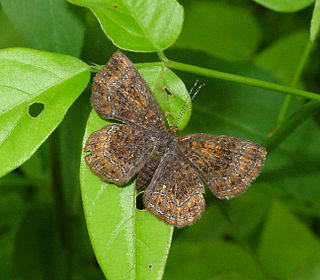 W
WCalephelis borealis, commonly known as the northern metalmark, is a butterfly of the family Riodinidae. It ranges through western Connecticut south through west-central Pennsylvania; central Appalachians and Ohio River Valley. Isolated populations are also found in southwest Missouri and eastern Oklahoma. The habitat consists of open woodland streams near serpentine, shale or limestone barrens.
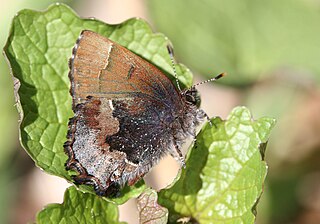 W
WCallophrys henrici, the Henry's elfin or woodland elfin, is a North American butterfly in the family Lycaenidae. In Canada it is found from southern Manitoba to southern Nova Scotia. It has two main groups of populations in the United States; the first is found along the Atlantic Coast and uses various hollies (Ilex) as host plants; and the second is found mainly in the north and the Appalachians where they use redbud as a host plant. Henry's elfin is increasing in New England because of an introduced buckthorn it now uses as a host plant. It is listed as a species of special concern in the US state of Connecticut.
 W
WCautethia is a genus of moths in the family Sphingidae first described by Augustus Radcliffe Grote in 1867.
 W
WDatana perspicua, the spotted datana, is a species of prominent moth in the family Notodontidae. It was described by Augustus Radcliffe Grote and Coleman Townsend Robinson in 1865 and is found in North America.
 W
WEuphyes bimacula, the two-spotted skipper, is a butterfly of the family Hesperiidae. It is found in North America, from northeast Colorado and western Nebraska; eastern Nebraska east to southern Quebec; southern Maine south to central Virginia; coastal plain south to Georgia; and the Gulf Coast.
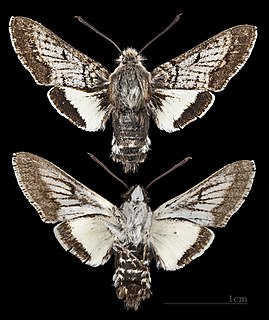 W
WEuproserpinus is a genus of sphinx moth in the family Sphingidae. The genus was erected by Augustus Radcliffe Grote and Herbert C. Robinson in 1865.
 W
WFeniseca tarquinius, the harvester, is a butterfly of the family Lycaenidae, and the only member of the monotypic genus Feniseca. It is found in eastern North America.
 W
WGnophaela vermiculata, the police-car moth or green lattice, is a moth of the family Erebidae. The species was first described by Augustus Radcliffe Grote in 1864. It is found in the western parts of North America, from British Columbia to California, east to New Mexico and north to Manitoba.
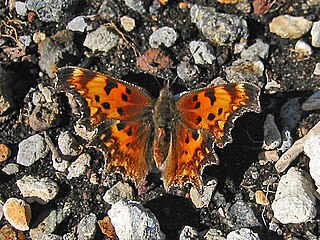 W
WThe hoary comma is a species of butterfly, common in boreal North America from Alaska, across southern Canada to New England and the Maritime Provinces and south to New Mexico from the Rocky Mountains to the Pacific Ocean. The wings have a distinctive ragged edge.
 W
WPapaipema speciosissima, the osmunda borer or regal fern borer, is a species of cutworm or dart moth in the family Noctuidae. It was described by Augustus Radcliffe Grote and Coleman Townsend Robinson in 1868 and is found in North America.
 W
WPiercolias is a Neotropical genus of butterflies in the family Pieridae. The name Piercolias was introduced by Augustus Radcliffe Grote as a replacement for Trifurcula Staudinger, 1894, which is invalid under the Principle of Homonymy.
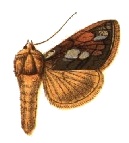 W
WPlusia putnami, the Lempke's gold spot or Putnam's looper moth, is a species of moth of the family Noctuidae. It is found in the Palearctic realm, from Japan and eastern Siberia to Fennoscandia, Great Britain, and France. In North America, it ranges from Newfoundland and Labrador to central Alaska and the interior of British Columbia, south to Pennsylvania, Washington, north-eastern California, and in the Rocky Mountains to Utah and Colorado.
 W
WThe hoary comma is a species of butterfly, common in boreal North America from Alaska, across southern Canada to New England and the Maritime Provinces and south to New Mexico from the Rocky Mountains to the Pacific Ocean. The wings have a distinctive ragged edge.
 W
WPyrgus communis, the common checkered-skipper, is a species of butterfly in the family Hesperiidae. It is known as the frequently seen Pyrginae species in the northern United States by collectors and watchers alike.
 W
WRiodinidae is the family of metalmark butterflies. The common name "metalmarks" refers to the small, metallic-looking spots commonly found on their wings. The 1532 species are placed in 146 genera. Although mostly Neotropical in distribution, the family is also represented both in the Nearctic and the Palearctic.
 W
WSatyrium edwardsii, the Edwards' hairstreak, is a species of butterfly in the family Lycaenidae. It is found in the eastern parts of the United States and in the southern parts of the Canadian provinces from Saskatchewan to Quebec.
 W
WThe Smerinthinae are a subfamily of Sphingidae moths in the order Lepidoptera.
 W
WSmerinthini is a tribe of moths of the family Sphingidae. The genus was erected by Augustus Radcliffe Grote and Herbert C. Robinson in 1865.
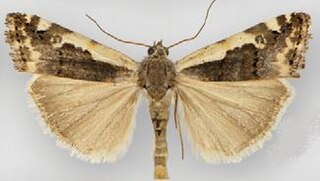 W
WTarache augustipennis, the narrow-winged midget, is a moth of the family Noctuidae. The species was first described by Augustus Radcliffe Grote in 1875. It is found in North America from Manitoba to south-western British Columbia, south to Arizona and east to Texas.
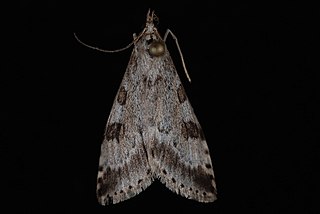 W
WUdea washingtonalis, the Washington udea moth, is a moth in the family Crambidae. It was described by Augustus Radcliffe Grote in 1882. It is found in North America, where it has been recorded from Alaska, British Columbia, California, Montana and Washington.
 W
WXylophanes ceratomioides is a moth of the family Sphingidae. It is known from Mexico, Belize, Costa Rica, French Guiana, Bolivia, Argentina and Venezuela, down into southern Brazil. Rare vagrants have been found up to southern Arizona.
 W
WZanclognatha laevigata, the variable zanclognatha, is a litter moth of the family Erebidae. It was described by Augustus Radcliffe Grote in 1872. It is found in North America from Manitoba to Nova Scotia, south to Florida and Missouri.
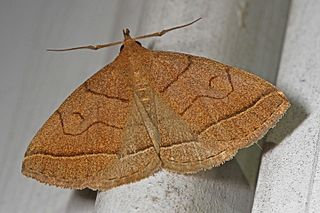 W
WZanclognatha obscuripennis, the dark zanclognatha, is a litter moth of the family Erebidae. It was described by Augustus Radcliffe Grote in 1872. It is found in North America from Missouri to Quebec, south to Florida and Texas.
 W
WZenodoxus is a genus of moths in the family Sesiidae.
 W
WThe Zerynthiini are a tribe of swallowtail butterflies.